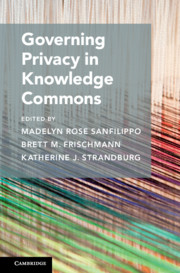Refine search
Actions for selected content:
48584 results in Computer Science
Voluntary use of automated writing evaluation by content course students
-
- Article
-
- You have access
- Open access
- HTML
- Export citation
Linear capabilities for fully abstract compilation of separation-logic-verified code
- Part of
-
- Journal:
- Journal of Functional Programming / Volume 31 / 2021
- Published online by Cambridge University Press:
- 30 March 2021, e6
-
- Article
-
- You have access
- Export citation
The effect of ultrafiltration transmembrane permeation on the flow field in a surrogate system of an artificial kidney
-
- Journal:
- Experimental Results / Volume 2 / 2021
- Published online by Cambridge University Press:
- 30 March 2021, e16
-
- Article
-
- You have access
- Open access
- HTML
- Export citation

Governing Privacy in Knowledge Commons
-
- Published online:
- 29 March 2021
- Print publication:
- 25 March 2021
-
- Book
-
- You have access
- Open access
- Export citation
PES volume 35 issue 2 Cover and Front matter
-
- Journal:
- Probability in the Engineering and Informational Sciences / Volume 35 / Issue 2 / April 2021
- Published online by Cambridge University Press:
- 29 March 2021, pp. f1-f2
-
- Article
-
- You have access
- Export citation
PES volume 35 issue 2 Cover and Back matter
-
- Journal:
- Probability in the Engineering and Informational Sciences / Volume 35 / Issue 2 / April 2021
- Published online by Cambridge University Press:
- 29 March 2021, pp. b1-b2
-
- Article
-
- You have access
- Export citation

Hey Cyba
- The Inner Workings of a Virtual Personal Assistant
-
- Published online:
- 26 March 2021
- Print publication:
- 08 April 2021
2 - How Private Individuals Maintain Privacy and Govern Their Own Health Data Cooperative
- from Part I - Personal Information as a Knowledge Commons Resource
-
-
- Book:
- Governing Privacy in Knowledge Commons
- Published online:
- 29 March 2021
- Print publication:
- 25 March 2021, pp 53-69
-
- Chapter
-
- You have access
- Open access
- HTML
- Export citation
22 - Artificial Intelligence
- from Part IV - Outlook
-
- Book:
- The Science of Science
- Published online:
- 07 February 2021
- Print publication:
- 25 March 2021, pp 231-240
-
- Chapter
- Export citation
2 - The h-Index
- from Part I - The Science of Career
-
- Book:
- The Science of Science
- Published online:
- 07 February 2021
- Print publication:
- 25 March 2021, pp 17-27
-
- Chapter
- Export citation
10 - Coauthorship Networks
- from Part II - The Science of Collaboration
-
- Book:
- The Science of Science
- Published online:
- 07 February 2021
- Print publication:
- 25 March 2021, pp 102-109
-
- Chapter
- Export citation
Index
-
- Book:
- Mathematical Foundations of Infinite-Dimensional Statistical Models
- Published online:
- 05 March 2021
- Print publication:
- 25 March 2021, pp 687-690
-
- Chapter
- Export citation
1 - Productivity of a Scientist
- from Part I - The Science of Career
-
- Book:
- The Science of Science
- Published online:
- 07 February 2021
- Print publication:
- 25 March 2021, pp 7-16
-
- Chapter
- Export citation
23 - Bias and Causality in Science
- from Part IV - Outlook
-
- Book:
- The Science of Science
- Published online:
- 07 February 2021
- Print publication:
- 25 March 2021, pp 241-251
-
- Chapter
- Export citation
5 - Random Impact Rule
- from Part I - The Science of Career
-
- Book:
- The Science of Science
- Published online:
- 07 February 2021
- Print publication:
- 25 March 2021, pp 51-59
-
- Chapter
- Export citation
Part I - Personal Information as a Knowledge Commons Resource
-
- Book:
- Governing Privacy in Knowledge Commons
- Published online:
- 29 March 2021
- Print publication:
- 25 March 2021, pp 51-148
-
- Chapter
-
- You have access
- Open access
- HTML
- Export citation
19 - The Time Dimension of Science
- from Part III - The Science of Impact
-
- Book:
- The Science of Science
- Published online:
- 07 February 2021
- Print publication:
- 25 March 2021, pp 197-208
-
- Chapter
- Export citation
16 - Citation Disparity
- from Part III - The Science of Impact
-
- Book:
- The Science of Science
- Published online:
- 07 February 2021
- Print publication:
- 25 March 2021, pp 174-183
-
- Chapter
- Export citation
5 - Public Facebook Groups for Political Activism
- from Part I - Personal Information as a Knowledge Commons Resource
-
-
- Book:
- Governing Privacy in Knowledge Commons
- Published online:
- 29 March 2021
- Print publication:
- 25 March 2021, pp 121-148
-
- Chapter
-
- You have access
- Open access
- HTML
- Export citation
20 - Ultimate Impact
- from Part III - The Science of Impact
-
- Book:
- The Science of Science
- Published online:
- 07 February 2021
- Print publication:
- 25 March 2021, pp 209-220
-
- Chapter
- Export citation


